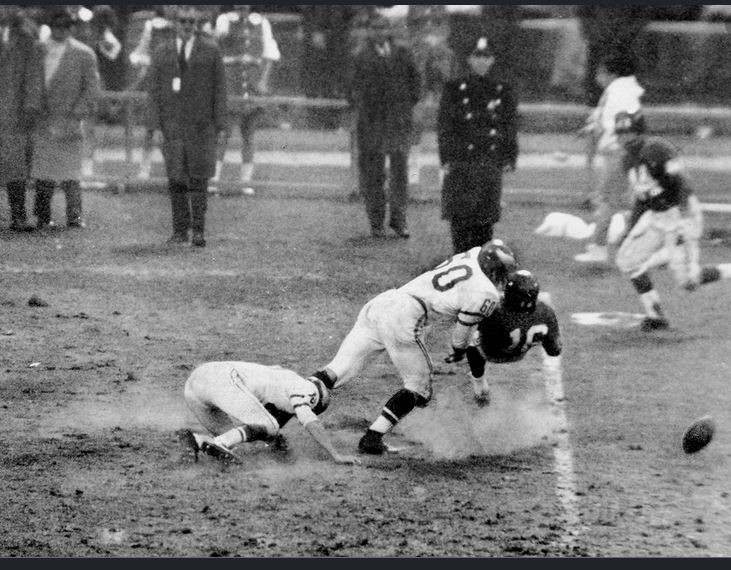More Than a Game
In November of 1960 the season was more than half over when the 6-1 Philadelphia Eagles met the 5-1-1 New York Giants with first place on the line in the NFL's Eastern Division. The Giants jumped out to a 10-0 first half lead, but the Eagles fought back to take a 17-10 advantage late in the fourth quarter.
The Giants were driving toward a tying score when Frank Gifford, their All-Pro halfback, ran a quick slant pattern across the middle. He caught the ball, but was knocked off his feet by Chuck Bednarik, a 6-foot-3, 235-pound outside linebacker, coming from the opposite direction.
The 6-foot-1, 185 pound Gifford was slammed backwards onto the half-frozen turf where he lay unable to move. Before he hit the ground, the ball came loose and middle linebacker Chuck Weber dove on the fumble to seal the victory that led the Eagles to the Eastern Division title, and eventually to a world championship win against the Green Bay Packers.
Gifford suffered a severe concussion on the play. He considered retiring, and sat out the next 18 months before returning to the Giants in 1962 in a new position as wide receiver.
Bednarik's tackle on Gifford became the stuff of legend – and illustrates the powerful conflicting forces at work in the arena of professional sports. Success, money and fame are all to be had by playing the game, but there's always the risk of severe, unexpected, and perhaps permanent consequences in return. And with such consequences often comes the added burden of financial distress.
In the early 1960s the average NFL player earned about $6,000 a year. Today, that average is about $2 million. In the NBA, the average salary last year exceeded $6 million.
Young professional athletes have no idea how long their careers will last, and it's important that they do long term planning from day one. Life insurance and its related products can offer young athletes some certainty about their biggest concerns:
- That their family is taken care of in the event of a fatal injury or disease.
- That they have a plan to provide a lifetime income stream to supplement their income after they retire.
- That they will have a suite of Living Benefits that can help pay for terminal illness, chronic illness, critical illness and critical injury expenses.
Chuck Bednarik and Frank Gifford were both lucky, in many ways. They both went on to finish their careers after that game in 1960, and both were eventually elected to the Pro Football Hall of Fame. They both lived long, full lives. But there's more to the story. Gifford died in August 2015, a week before his 85th birthday. Upon his death, his family released a statement revealing that he had suffered from chronic traumatic encephalopathy (CTE).
Earlier that year, Chuck Bednarik had died as well. He was 89. The Philadelphia Eagles released a statement saying he died after a "brief illness," but Bednarik's eldest daughter, Charlene Thomas, disputed that claim. "He died from dementia from football-related head injuries," Thomas said in a phone interview. "It was not brief."
As we said earlier, young professional athletes have no idea how long their careers will last, or what the long-term consequences of their playing careers will be. As a financial professional, you are in an ideal position to help them make the right choices now, to ensure that their families and their futures are financially secure both today and tomorrow.
Watch for new product solutions and sales ideas to help you serve the needs of professional athletes – coming soon from Windsor!


Comments